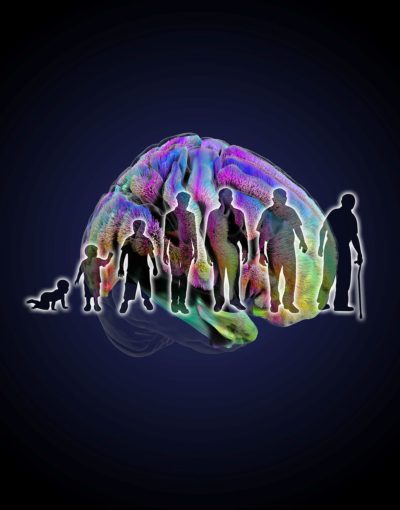By Sidney Taiko Sheehan

Pacific Rim New Horizons in Human Neuroimaging: Neuroimaging across the Lifespan. Image courtesy of James Stanis, Caroline O’Driscoll, Arthur Toga.
In early February 2020, prior to sweeping lockdowns due to the pandemic, the USC Mark and Mary Stevens Neuroimaging and Informatics Institute (USC INI) at the Keck School of Medicine of USC, hosted the Pacific Rim New Horizons international conference. Uniting renowned experts, rising leaders, and early-stage investigators from around the world under the theme “neuroimaging across the lifespan,” the three-day meeting sought to determine the future research and initiatives necessary to advance our understanding of the brain at every stage of life.
Now, as a result of the conference, the journal Brain Imaging and Behavior has published Special Issue: 2020 Pacific Rim New Horizons in Human Brain Imaging: Neuroimaging across the Lifespan. This collection highlights ten original research reports led by several of the conference attendees.
“What makes the INI so influential is our immense data repository and computational power, our advanced imaging technology, and our emphasis on collaboration. We work with researchers and institutes all over the world. But bringing dedicated investigators together for a discussion-heavy meeting united under one theme is an especially powerful way to assess where we are and where we need to go,” says USC INI Director Arthur Toga.
The human brain develops and changes throughout life, and numerous factors like genetics, environment, and life experiences influence these changes, which makes the brain arguably the most difficult organ to understand. Not all of these changes are observable or obvious to the naked eye, which is why advances in neuroimaging have become crucial. The complexity of understanding the function and structure of the brain at a single moment in time is challenging enough, let alone unlocking its mysteries throughout the course of an entire life. And yet, this is exactly what the USC INI and researchers who attended the Pacific Rim New Horizons conference endeavor to do.
Brain Imaging and Behavior’s special issue is guest edited by Neda Jahanshad, PhD and Xi-Nain Zuo, PhD. Jahanshad is part of the INI’s Imaging Genetics Center, where she performs and develops tools for large-scale analyses of brain structure and connectivity to understand risk factors for brain aging and mental illnesses.
“This conference brought together diverse speakers from around the Pacific Rim. As a result, this special issue uniquely showcases a variety of study designs, brain imaging modalities, and diverse populations across the lifespan. The research highlighted ranges from how maternal BMI might predict an offspring’s brain reactivity to food, to how brain development can be altered by traumatic brain injury, to how environment and lifestyle contribute to brain aging, and more,” says Jahanshad.
“Bringing together these researchers to focus on the characterization, measurement, and analysis of the brain over the lifespan was such a meaningful way to combine resources and optimize the way we collect information,” Jahanshad added. “In this era of big data and near-constant technological advancement, these tools merely provide the foundation for gaining insights into the brain. It’s the cooperation and partnership of researchers, ready to share and influence each other, that truly drives innovation. I’m looking forward to the future when we can safely meet again to delve deeper into this work.”
The 2020 Pacific Rim New Horizons in Human Brain Imaging: Neuroimaging Across the Lifespan meeting was made possible by the support of our generous funders: Bracco Diagnostics; Siemens Healthcare; The Mark and Mary Stevens Neuroimaging and Informatics Institute; The Laboratory of Neuro Imaging Resource (P41EB015922); The Australian Research Council (ARC) Centre of Excellence for Integrative Brain Function (CE140100007); Monash Biomedical Imaging, Monash University; The Department of Neuroscience, Central Clinical School, Monash University; The Ludmer Centre for Neuroinformatics and Mental Health; The USC Leonard Davis School of Gerontology. The authors acknowledge support from NIH grants P41EB015922, R01MH116147, R01AG059874, Start-up Funds for Leading Talents at Beijing Normal University “Developmental Population Neuroscience,” National Basic Science Data Center “Chinese Data-sharing Warehouse for In-vivo Imaging Brain” (NBSDC-DB-15).